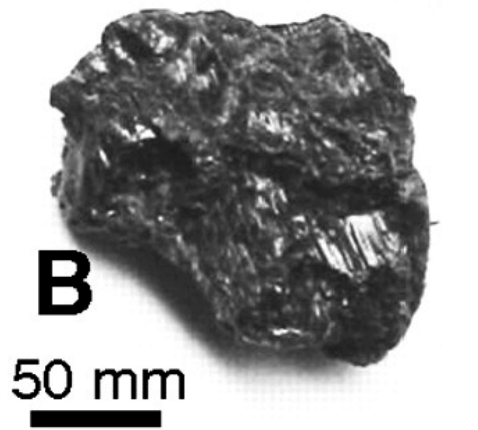![]()
![]() What does faulting do to a rock 2 miles beneath the Earth’s surface? Thanks to the San Andreas Fault Observatory at Depth (SAFOD) project, which retrieved samples across an active segment of the San Andreas Fault from 3000m below the Earth’s surface, we can answer this question: it turns it into fragments a little like this:
What does faulting do to a rock 2 miles beneath the Earth’s surface? Thanks to the San Andreas Fault Observatory at Depth (SAFOD) project, which retrieved samples across an active segment of the San Andreas Fault from 3000m below the Earth’s surface, we can answer this question: it turns it into fragments a little like this:

Polished and striated rock chip from fault zone in SAFOD borehole. Source: Schleicher et al., Fig. 1B.
Anja Schleicher and her co-authors found abundant fragments like the one above, with polished and striated fracture surfaces formed by strike-slip motion of the San Andreas fault, which collectively make up a fault gouge – or, less technically, a really really smashed up rock – in the fault zone. However, as they report in their recently published paper in Geology, closer examination and chemical analysis of these fracture surfaces reveals something rather interested – a thin coating of clay minerals such as illite. These minerals’ growth patterns, and radiometric dating of their time of formation, demonstrate that they post-date the fracturing – they grew on the polished grain surfaces at some point after the rock was broken apart.
What makes this discovery particularly interesting is that the SAFOD borehole was drilled through a part of the San Andreas Fault which ‘creeps’: there is fairly continuous, slow movement, rather than the stick-slip behaviour that generates large earthquakes. It seems that in this region, the friction between the two sides of the fault is too low for any significant elastic strain to build up before the fault moves. These new observations suggest that the cause of this weak, creeping behaviour is the growth of the illite and other clay minerals within the fault rock; these new minerals then act as a lubricant that reduces friction and allows more continuous deformation. This contrasts with the hypothesis put forward when the borehole samples were first unveiled a couple of years ago, which pointed to the presence of serpentinite (and talc derived from the breakdown thereof) within the units being deformed as the explanation for creep.
A further implication of these observations is that creeping behaviour is a function of the age of the fault. The polished and striated rock fragments testify to the fact that the rock intersected by the borehole was originally shattered by brittle failure, which produces earthquakes. Schleicher et al. propose that this initial fracturing allows fluids to more easily circulate through the fault zone, speeding up chemical alteration and producing the clay minerals. They initially occur in small, unconnected pockets, but further seismic motion and alteration eventually link the clay-rich regions together into larger fractures that can accommodate tectonic strain by slow creep rather than jerky sticking and slipping. It’s a kind of reverse arthritis – rather than seizing up, the older Earth’s tectonic joints get,the more freely they may move.
Questions remain, however. Whilst the segment of the San Andreas Fault sampled by SAFOD deforms mainly by creep, it is right next door to rather more seismically hazardous sections that do not. In a press release accompanying the paper, co-author Ben van der Pluijm suggests that the difference is due to activity being focussed on either older, clay-lubricated or younger, stronger, strands of the fault system; however, I’m uncertain why activity would shift away from weaker areas of the crust into stronger ones like that. Another possiblity is that the growth of clay minerals proceeds at different rates in different parts of the fault, being controlled or limited by lithology, or the amount and/or composition of circulating fluids. Interesting as this finding is, there’s still plenty more work to do before we truly understand why faults behave the way they do.
Schleicher, A., van der Pluijm, B., & Warr, L. (2010). Nanocoatings of clay and creep of the San Andreas fault at Parkfield, California Geology, 38 (7), 667-670 DOI: 10.1130/G31091.1



Nice plan for content warnings on Mastodon and the Fediverse. Now you need a Mastodon/Fediverse button on this blog.